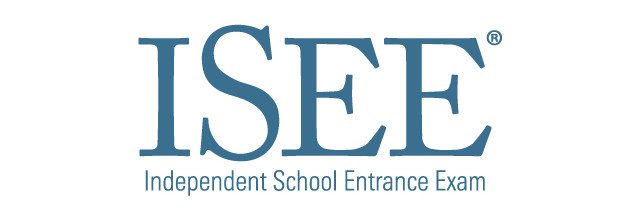
Reduce Stress by Knowing the ISEE – An Everything Guide
Every year, I talk to hundreds of parents about the ISEE. This is my 8th year doing ISEE Prep and each year, families come to Davidson with questions, anxiety and specific concerns. There is a community of parents in Los Angeles who love their kids and wants the best for them, but often the peer pressure and rumors, combined with geographic limitations and school choices make the application process far more difficult and stressful for these families that it needs to be.
I hope this article dispels a lot of the myth and mystery surrounding the ISEE and the application process, so you can make more informed decisions about the best next steps for your child and your family.
The ISEE – Start Here
Davidson Tutoring is not affiliated with the ISEE test creators in any way. The ISEE is written by a company called the Educational Records Bureau, this is the same company that writes the CTP4 test (which a lot of schools in the area call the ERB). This is the test that most private school students take in the spring to assess their reading, writing and math skills at their age group. To register for the ISEE, go to their website (www.erblearn.org). They also have a free downloadable guide called “What to Expect on the ISEE” for each level of the ISEE with a partial test, sample questions and basic breakdown of the different sections of the test. Set aside time to download it and read it. That – along with this blog post- will inform you tremendously about test content and layout and give you information to help make better decisions for your student and their test prep.
Levels?
Yes, the ISEE has three levels, all based on the grade your child will be applying into the following year. The Lower Level ISEE is for students entering 5th or 6th grade. The Middle Level ISEE is for students entering 7th or 8th grade. The Upper Level ISEE is for students entering 9th, 10th or 11th grade. The majority of students we work with sit the Middle or Upper Level test since most Los Angeles private elementary schools end in 6th grade. Each test contains Math, Reading and Vocab that spans multiple grades based on the national content standards.
How do they arrange all those questions?
The ISEE has 4 scored sections in the following order:
- Verbal Reasoning
- Quantitative Reasoning
- Reading Comprehension
- Math Achievement
- An (unscored) Essay.
There are different amounts of questions in each section. I’ll cover that in the Pacing Section.
The test covers a lot of material in a short amount of time. By the time these kids get to the essay at the end of the test, they are running on fumes! There is a huge amount of content on this test that expands a few grade levels ahead of what these students have learned in school. Combine that with a high-stakes testing environment and unfledged test-takers and you have potential for major panic and anxiety. However, being prepared and reasonable about your goals and the scores you need can help you and your child have fair expectations that will assuage the apprehension and uncertainty that often accompanies this process.
Knowing that most schools aren’t looking for 8s and 9s in order to accept a good candidate can help you build a reasonable timeline and fair expectations for your student. For more information on choosing schools, see our blog about school fit. (https://www.davidsontutoring.com/blog/2017/09/07/private-secondary-school-best-student/)
Pacing
Pacing during the ISEE tends to be the biggest hurdle for our students. Most of us can answer a myriad of Math questions, or read a passage and select a multiple choice answer. However, once the timer starts to run and we see the minutes slipping away, the propensity to panic and rush can get the best of us.
What do I mean? Take a look at the charts below. The amount of questions the students have in each section and the time set for each section puts any Six Flags coaster to shame.
Lower Level Test
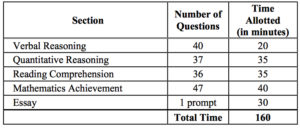
Middle and Upper Level Test
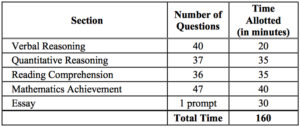
What does this mean for students? They have about 2 minutes (less in some cases) to answer each question. Given the time constraints and the content, students rarely answer each and every question correctly. The ISEE is not set up that way. There is no expectation for students to correctly answer every question.
Students don’t need to crack a book and learn every single word or problem that will be on the test. They don’t need to know every vocabulary word on the test either. They need to spend time on the questions they can answer, guess the questions they can’t (and have the wisdom to know the difference). The goal is to have a solid understanding of the wide base of ISEE material, even if the more complicated or advanced concepts elude them.
Test Content
The big issue that students have to face when preparing for the test is that other students of different age groups will also take this test. There is an inordinate amount of Math on this test that students have not seen yet in their schoolwork. This test is designed to challenge a 7th grader who is taking the Middle Level test, so a 6th grader will see questions from Alg. 2 and Geometry that are totally new to them. An 8th grader will see content up to 11th grade that will be equally foreign to them. A student may assume they are behind or are not up to the task when faced with the high difficulty level of the material in the Math or the fast-paced, lengthy reading comprehension passages with dense writing-styles and esoteric content. Without adequate prep, a student may wrongfully assume they are behind. Part of the work of our instructors is to discuss the boundaries of the test and how there is no expectation for a student to know everything.
What is a good score and how do they do it?
The scoring system for this test causes a good deal of head-scratching and theorizing by even the most advanced statistician. We have poured over score reports, counted missed questions, spoken to staff at the ERB Board and still cannot land on a way to succinctly explain how this system works. As a policy, we don’t like to discuss or predict scores with our students. They work best with the raw score in each section without us cranking the data through an elaborate number machine. Translating scores with them leads to a bit of confusion and obfuscating the actual goal, which is to pace themselves and do their best.
For our parents, here is some information to help you demystify the system. Attempting to predict scores is always sticky and when we work with you to get stanines, they are guesses because we don’t have the norm group of student data that the ERB board is using to scale the students raw data.
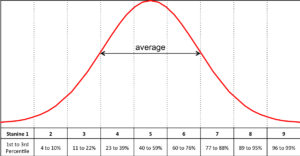
The students receive a raw score in each section that translates into a percentile ranking between 1 and 99, so their converted raw score means the student performed as well as a percentage of students who took the same test. The students are slotted into these percentiles based on the “norm group’ or ‘pool’ of students who have only taken that same test number.
The ‘pool’ of students is the group of students who have taken the test over the last 3 years (not including this current year). Their percentile rank might be different from one year to the next depending on how students in past years performed applying into their same grade when taking that same test number. The numbers change from year to year.
The scores from the students’ ranked percentiles are then grouped into stanines, which range from 1 (lowest score) to 9 (highest score). A student in the 1st to 3rd percentile rank receives a stanine score of 1, according to the chart above.
On average, students receive 4s and 5s most often because the highest percentile of students perform in the mid-range. The ERB board does distribute stanines in the mid-range more often than in the upper or lower stanines.
How About Those Scores??
The term ‘smoke and mirrors’ does not come close to describing the odd and obtuse process used to score your child’s test. I often say I cannot predict scores and I think any test prep company or experienced parent will say the same. Here are some facts about how the ERB board uses raw scores to get an ISEE stanine. Hopefully, this will explain why no test prep company can give you a precise prediction of what your child’s score might be.
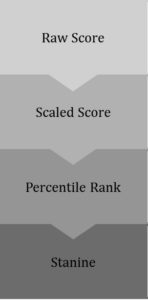
Raw Score
Each question on the ISEE is worth one point. Students do not get points deducted for guessing. The final total of all of their correctly answered questions gets tallied up into a raw score in each section. When you get your child’s score report back, it will tell you how many questions your child answered correctly in each section out of the total amount of questions they answered or skipped for each section.
Scaling
Your student will take one of many ISEE tests in circulation. Their raw score is compared to a norm group of the same age group who took that same test over the last 3 years. Your student is not compared to the group of kids they are taking the test with that day. They are compared to a group of students who have taken the test in the past. That group of students changes every year, thus the inconsistency and inability of anybody outside of the ERB board to accurately predict scores because the norm group changes every year. They are placed in a percentile ranking, so they receive a rank or place in each section that is comparative to the percentage of students who have taken that test. If they get 33 out of 40 questions right, but everybody else who has taken the test in the norm group answered 33 of the 40 questions correctly, then your child may end up in the 99th percentile, even though they missed 7 questions. Conversely, if the norm group got 40 out of 40 questions on the verbal and your child misses a question, they may end up in the 80th percentile, depending on how past students performed on that section of the test. The question is how your child performed compared to the 1 to 99th percent of students who have also taken that test. That determines their percentile ranking.
This is the dicey part of ISEE scoring. No one outside of the organization actually knows what that percentage ranking will be from year to year.
Stanines
Once your child receives a percentile rank, then the scores are grouped into stanines. You can see the chart below, but, essentially, the 1-9 stanine gives the admissions team a clear assessment of where your child falls on the scale.
If a child falls on the lower scale of the percentile ranking but still received a 6 stanine, that means that they are as strong as a test taker as a student who scored higher on the percentile ranking on a different test but still received the same score. The stanine system clarifies what might be an unclear read of a child’s performance on the percentile ranking.
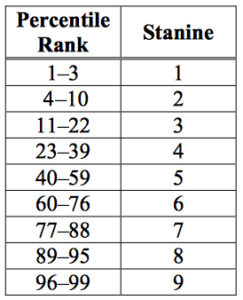
Distribution of Stanines
Each student’s score falls within one of the nine segments of the stanine scores, however, if you look at how many students receive a 6 (16 percentage points) compared to how many students receive a 1 (3 points) or a 9 (3 points), it’s clear that the majority of the students who take the test land in the mid-range area. The higher up or down you go on that stanine key, the smaller the amount of students will be who receive both the very high and very low scores. This stanine key stays the same each year, even though the norm group changes.
What does that mean for my hard-working, gifted child?
Admissions teams across Los Angeles know that this is not an easy test. They also know that a small percentage of test takers (23%) will receive a stanine of 7, 8 or 9.
Considering this, our goal with ISEE prep for all of our students is to reduce their stress levels by demystifying the content and give them tools to identify the what they know and answer quickly and accurately. We want them to feel confident that they know how to do their absolute best on test day.
The Score Report, how long will that take?
Most ISEE tests are scored within 2-3 days of a student taking the test. It usually doesn’t take more than a week for schools to receive the ISEE reports. You can pay a $40 expedited fee to get the scores sooner and you can either call in to get them or access them online.
The Limits of Tutoring
The ISEE is a hard test. Each level contains Math that they have most likely never seen yet, vocabulary that is advanced for their age, reading passages that are dense and long and, to top it all off, they have to finish with an essay that showcases their best selves after they’ve been run through an exhausting academic maze.
There’s no getting around a child’s need to come with an already strong academic foundation from school in order to get high scores on the test. Our tutors work hard and the students work hard, but a test prep course is no replacement for a strong foundation, particularly in Math. The expectation that a 12 to 24 week round of test prep can teach a child the fundamentals of Whole Numbers, Geometry, Algebra and Fractions is an unfair burden to place on these kids. Plus, it goes against all past research about long-term learning and a child’s neurological and cognitive development. That said, the schools in the area know that the ISEE is a tough test and the pool of students they accept each year reflects a wide range of scores and abilities, contrary to the myth that you need to get 8s and 9s in order to get accepted to a competitive private school in the area. More on that later. . .
The ISEE test is only a piece of a large process, and we’ve seen time and again that the admissions teams at schools across Los Angeles take a lot of different factors into account. They look at the big picture of what a student brings to the school, where the student is coming from, and how they will contribute to the overall student body and culture of the school. They also assess the parents and siblings and make a decision that extends beyond scores. Much goes into their decisions that is not influenced in any way by the ISEE test. High scores won’t change their minds if they feel the family or the student is not a good fit for the school.
If you, as a family, invest the time in the beginning to find a school that is a good fit, you will feel more confident that you have made the right decision and have really explored all of the options.
Reducing Stress, Being Reasonable and Keeping Things in Perspective
The expectation for an admissions team is to build a good class, not selectively choose the best scores. We follow our students both during the ISEE and after they take their test and the ISEE score does not reliably predict a student’s ongoing academic success. It does not show how well a student will behave when running for student government or whether they will take a risk and try out for water polo when they’ve been doing soccer for years.
The ISEE has comprehensive content coverage that ranges from logic to high difficulty in word problems, unusual question formatting, lengthily passages and dense content. Our goal with ISEE prep has never been and never will be an influx of information thrown at a student with the hopes that enough will stick so that they’ll be able to answer every slope and statistics questions. We absolutely prefer pacing out the information, filling in gaps using diagnostic test information and making their academic base stronger. We also believe that a student needs a good understanding of what the test is like and the test taking strategies that best fit their academic base and learning style.
We give students tools to reduce their anxiety help them identify and know their strengths on the test ahead of time. After a student finishes a full course with us, they will know where they are likely to make errors by rushing and how to avoid careless mistakes that will cost them points.
Should We Cram and Get as Much Tutoring As Possible?
Reasonable ISEE prep means that students have taken multiple practice tests. They’ve worked through a strategies that they feel comfortable using in each section. They know and can anticipate the question types they can answer, and they won’t be rattled when they see content pop up on the test that they cannot answer. Reasonable prep means spending about 2-3 months going over materials and usually meeting with their instructor once or twice a week. It does not mean 6 months of intensive tutoring or meeting 3 to 4 times a week. We want to be sensitive to the fact that our students will learn better by getting sizable chunks of information over time and by spending time on their own independently working to reinforce what they’ve learned with their instructor.
We hear stories every year of students having panic attacks during the test, kids who faint or throw up or draw a blank and can’t answer a single question. Those are not our students because our kids are prepared. They’re confident because they are informed. Our ongoing goal is not over-prep and an inundation of information, it’s a planned out curriculum with goals in place and an end date in mind that helps the students stay focused, feel prepared and at ease on the big day.
We sincerely hope this post helps you feel at ease and less anxious about this process and the test itself. This is a lot of information to digest, so take your time and reference it as needed. The more information you have, the more confident you can be that you have explored the options and made the decisions that best fit your family and your child.
